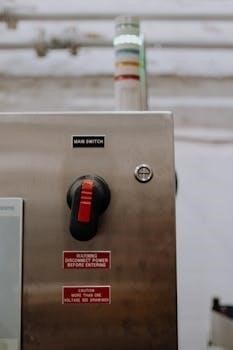First Alert carbon monoxide detectors offer crucial home safety․ These devices are designed to provide early warning of carbon monoxide presence․ Understanding the detector’s operation and following instructions is vital․ Proper installation, regular testing, and prompt response to alarms ensure maximum protection for your family․
Understanding Carbon Monoxide (CO)
Carbon monoxide (CO) is an odorless, colorless gas produced by incomplete combustion․ Common sources include furnaces, gas stoves, vehicles, and generators․ Because it’s undetectable by human senses, CO can accumulate indoors, posing a serious health risk․
CO interferes with the blood’s ability to carry oxygen, leading to symptoms like headaches, dizziness, nausea, and even death․ Prolonged exposure to even low concentrations can have lasting health effects․
Understanding CO’s dangers emphasizes the importance of carbon monoxide detectors․ These devices monitor CO levels and alert occupants to potential hazards, providing crucial time to evacuate and seek fresh air․
First Alert CO detectors are designed to detect CO from various sources, offering continuous monitoring․ Familiarizing yourself with CO’s properties and potential sources is the first step in protecting your home and family from this silent killer; Remember to never ignore a CO alarm!
Importance of CO Detectors
Carbon monoxide (CO) detectors are vital safety devices in any home․ Since CO is odorless and colorless, humans cannot detect it without technology․ CO detectors provide an early warning system, alerting occupants to dangerous CO levels before they experience symptoms․
These detectors offer continuous monitoring, ensuring around-the-clock protection against this silent killer․ Properly functioning CO detectors can save lives by providing crucial time to evacuate and seek medical attention․
First Alert CO detectors are designed to meet rigorous safety standards, offering reliable performance․ They play a critical role in preventing CO poisoning, which can lead to severe health complications and even death․
Installing CO detectors is a simple yet effective way to enhance home safety․ Regular testing and maintenance are essential to ensure they function correctly․ Prioritizing CO detection contributes significantly to a safer living environment for you and your family․ Remember, ignoring a CO alarm can have deadly consequences․
Where to Install CO Detectors
Proper placement of carbon monoxide (CO) detectors is crucial for effective monitoring․ Install at least one CO Alarm near or within each separate sleeping area․ This ensures that occupants are alerted while they are most vulnerable․ For added protection, install an additional CO Alarm at least 20 feet from any fuel-burning appliance․
On a peaked, gabled, or cathedral ceiling, install the first Smoke/CO Alarm within 3 feet of the peak of the ceiling, measured horizontally․ Avoid placing detectors in dead air spaces, such as corners or near obstructions․
Do not install CO detectors in garages or kitchens, where normal activities may cause false alarms․ Keep detectors away from direct sunlight, drafts, and excessive moisture․ Follow these guidelines to maximize the effectiveness of your First Alert CO detectors․
Remember, optimal placement ensures that CO is detected quickly, providing you with the earliest possible warning․ Regularly check and adjust placement as needed to maintain comprehensive coverage throughout your home․ Prioritizing correct installation is a key step in protecting your family from carbon monoxide poisoning․
Optimal Placement Guidelines

To ensure your First Alert CO detector functions effectively, adhere to specific placement guidelines․ Mount CO alarms on walls, ideally about five feet from the floor․ This height allows for optimal detection as carbon monoxide can mix evenly throughout the room․ Avoid placing detectors directly above or near fuel-burning appliances․
In homes with multiple levels, install a CO detector on each level, including the basement․ Prioritize placement near sleeping areas to provide early warning during the night․ Keep detectors at least 10 feet away from sources of humidity, such as bathrooms or laundry rooms․
Do not install CO detectors in turbulent air environments, such as near open windows or ceiling fans․ These conditions can dilute CO levels, delaying detection․ For optimal performance, follow the manufacturer’s instructions included with your First Alert CO detector․
Regularly inspect the placement of your detectors to ensure they remain in suitable locations․ Adjust as needed to accommodate changes in your home environment․ Proper placement significantly enhances the reliability and effectiveness of your CO detection system․
Types of First Alert CO Detectors
First Alert offers a diverse range of carbon monoxide detectors to suit various needs and preferences․ These detectors primarily fall into two categories⁚ battery-operated models and plug-in models with battery backup․ Each type offers distinct advantages, catering to different installation requirements and user preferences․
Battery-operated models provide flexibility in placement, allowing installation in areas without readily available electrical outlets․ These models are ideal for rooms where wiring is limited or for portable use in RVs or during travel․ They rely solely on battery power, requiring regular battery replacements to ensure continuous operation․
Plug-in models with battery backup offer the convenience of continuous power from an electrical outlet while providing backup power in case of outages․ These models are typically equipped with a battery compartment that houses batteries for emergency use․ This ensures that the detector remains operational even during power failures, enhancing safety and reliability․
Both types of First Alert CO detectors utilize advanced sensing technology to detect carbon monoxide․ Selecting the appropriate type depends on your specific needs and preferences․
Battery-Operated Models
Battery-operated First Alert CO detectors offer unparalleled flexibility and ease of installation, making them a popular choice for many households․ These detectors operate solely on battery power, eliminating the need for electrical outlets and allowing placement in virtually any location within your home; This is particularly advantageous in areas where wiring is limited or non-existent, such as basements, attics, or garages․
The primary benefit of battery-operated models lies in their portability; They can be easily moved from room to room, making them ideal for use in RVs, campers, or while traveling․ This ensures continuous CO monitoring wherever you go, providing peace of mind and added safety․
However, it’s crucial to remember that battery-operated detectors rely entirely on battery power․ Regular battery replacements are essential to maintain continuous operation․ First Alert recommends replacing batteries at least every six months or immediately upon receiving a low-battery warning․ Using high-quality batteries ensures optimal performance and extends the lifespan of your detector․ Despite regular maintenance, battery models can provide years of service․
Plug-In Models with Battery Backup
Plug-in First Alert CO detectors offer a blend of convenience and reliability․ They plug directly into a standard electrical outlet for primary power, ensuring continuous monitoring without relying solely on batteries․ This eliminates concerns about frequent battery replacements while providing consistent CO detection․ The added battery backup feature provides an extra layer of security, ensuring functionality during power outages․

In the event of a power failure, the detector seamlessly switches to battery power, maintaining uninterrupted CO monitoring․ This is crucial during storms or electrical issues when carbon monoxide risks might increase due to alternative heating sources․ The battery backup typically consists of AA batteries, which should be replaced annually or when the detector indicates a low-battery condition․
Plug-in models often include additional features such as digital displays that show current CO levels․ Some models also have silence buttons to temporarily quiet the alarm during false alerts, such as those caused by cooking fumes․ Installing a plug-in model is straightforward, requiring only access to an electrical outlet․ However, it’s essential to follow the manufacturer’s instructions for proper placement and testing to ensure optimal performance․
Testing Your CO Detector
Regularly testing your First Alert CO detector is crucial for ensuring it functions correctly and provides adequate protection against carbon monoxide poisoning․ Testing confirms the alarm’s ability to sense CO and alert you to potentially dangerous levels․ A non-functioning detector offers no protection, making periodic checks essential for your family’s safety․ First Alert recommends testing your CO detector at least once a week․
The testing process is simple and usually involves pressing the “Test” button on the detector․ This button simulates the presence of CO, triggering the alarm if the device is working correctly․ When the button is pressed, the alarm should sound a loud, distinct pattern, indicating that the sensor and alarm system are operational․ If the alarm does not sound, it may indicate a battery issue or a malfunctioning unit;
If the detector fails the test, first check the batteries․ Replace them with new ones and retest the unit․ If the alarm still doesn’t sound, the detector may need to be replaced․ Keep a record of your testing dates to ensure consistent monitoring․ Regular testing, combined with proper maintenance, ensures your First Alert CO detector remains a reliable safeguard against the dangers of carbon monoxide․
Regular Testing Procedures
To ensure your First Alert CO detector is functioning correctly, adhere to a consistent testing schedule․ First Alert recommends testing your CO detector at least once a week․ This frequency helps guarantee the device’s sensors and alarm system are always ready to detect and alert you to the presence of carbon monoxide․ Regular testing is a simple yet crucial step in maintaining a safe home environment․
The standard testing procedure involves locating the “Test” button on your First Alert CO detector․ Press and hold this button for a few seconds․ The alarm should sound a loud, clear pattern, indicating that the device’s sensing and alarm components are working․ If the alarm doesn’t sound, it suggests a potential problem․ Begin by checking the batteries; replace them with fresh ones and repeat the test․
If the CO detector still fails to respond after replacing the batteries, the unit may be defective and require replacement․ Document the dates of your tests to keep track of the detector’s performance․ By following these regular testing procedures, you can confidently rely on your First Alert CO detector to provide timely warnings, protecting you and your family from the silent threat of carbon monoxide poisoning․
Interpreting Alarm Sounds
Understanding the different alarm patterns of your First Alert CO detector is crucial for a swift and appropriate response․ CO detectors use distinct sound patterns to differentiate between various alerts, ensuring you can take the necessary action․ The primary alarm signal for carbon monoxide detection is typically four quick beeps followed by a pause, repeating continuously․ This pattern signifies that the detector has sensed a dangerous level of CO․
Some First Alert CO detectors also feature different alarm sounds for low battery warnings․ A common low battery signal is a single “chirp” sound that occurs periodically, usually every minute․ This indicates that the batteries need to be replaced soon․ It is essential to replace low batteries immediately to maintain continuous protection․
Additionally, be aware of any error or malfunction signals your detector might produce․ These can vary by model but often include a series of chirps or beeps distinct from the CO and low battery alarms․ Refer to your user manual to correctly identify these specific signals․ By familiarizing yourself with these sounds, you can accurately interpret alarm sounds and respond effectively to potential CO threats․
What to Do When the Alarm Sounds
When your First Alert CO alarm activates, it indicates a potentially life-threatening situation requiring immediate action․ NEVER ignore your Carbon Monoxide Alarm․ The first and most crucial step is to remain calm and avoid panic․ Immediately move to a location outside the building where fresh air is abundant․ Ensure that everyone in the household, including pets, is evacuated safely․
Once you are in a safe location, call emergency services or the fire department․ Provide them with your location and explain that your CO alarm is sounding․ Do not re-enter the building until emergency personnel have arrived, assessed the situation, and given the all-clear․ Professionals will use specialized equipment to determine if dangerous levels of carbon monoxide are present and identify the source․

If no one is experiencing symptoms of CO poisoning, ventilate the building by opening windows and doors after the emergency responders have investigated and deemed it safe․ Even if the alarm stops sounding after ventilation, do not assume the problem is resolved․ Contact a qualified technician to inspect your fuel-burning appliances, such as furnaces, water heaters, and stoves, to identify and repair the source of the CO leak․
Locating the Source of CO
Identifying the source of carbon monoxide (CO) after an alarm is crucial for preventing future incidents․ Carbon monoxide is an odorless, colorless gas, making it difficult to detect without proper equipment․ After ensuring everyone’s safety and ventilating the area, the next step is to systematically investigate potential sources․
Begin by checking all fuel-burning appliances․ This includes furnaces, water heaters, stoves, ovens, fireplaces, and portable heaters․ Look for signs of malfunction, such as damaged vents, rust, or soot accumulation․ Ensure that all appliances are properly vented to the outside․ Check chimneys and flues for obstructions like bird nests or debris that could prevent proper ventilation․
If you have a garage attached to your house, inspect any vehicles or gasoline-powered equipment stored there․ Never run a car or generator inside a closed garage, even with the door open, as CO can quickly seep into the house․ If you suspect a particular appliance is the source, turn it off immediately and contact a qualified technician for inspection and repair․ If the source remains unknown, consider contacting your gas company or fire department for assistance in locating the leak․
Replacing Batteries and Maintenance

Maintaining your First Alert CO detector is essential for its proper functioning and your safety․ Regular battery replacement ensures the detector remains operational during power outages․ Replace the batteries at least once a year or immediately when the low-battery indicator activates․ Use fresh, high-quality batteries for optimal performance․ DO NOT use rechargeable batteries, as they may not provide sufficient power․
Cleaning your carbon monoxide detector is also important․ Dust and debris can accumulate, affecting the sensor’s accuracy․ Gently vacuum the exterior of the detector with a soft brush attachment every few months․ Avoid using cleaning solutions or solvents, as they may damage the sensor․
Test the detector regularly, following the manufacturer’s instructions․ This ensures that the alarm and sensor are functioning correctly․ If the detector fails the test or exhibits any malfunctions, replace it immediately․ Carbon monoxide detectors have a limited lifespan, typically around 5-10 years․ Check the expiration date on your detector and replace it when necessary․ Proper maintenance ensures reliable protection against carbon monoxide poisoning․
